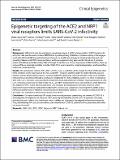Por favor, use este identificador para citar o enlazar a este item:
http://hdl.handle.net/10261/255729COMPARTIR / EXPORTAR:
 SHARE SHARE
 CORE
BASE CORE
BASE
|
|
| Visualizar otros formatos: MARC | Dublin Core | RDF | ORE | MODS | METS | DIDL | DATACITE | |

| Título: | Epigenetic targeting of the ACE2 and NRP1 viral receptors limits SARS-CoV-2 infectivity |
Autor: | Saiz, María Laura; DeDiego, Marta L. CSIC ORCID ; López-García, Darío; Corte-Iglesias, Viviana; Baragaño Raneros, Aroa; Astola, Iván; Asensi, Víctor; López-Larrea, Carlos; Suárez-Álvarez, Beatriz | Palabras clave: | SARS-CoV-2 ACE2 HDAC Epigenetics NRP1 Valproic acid |
Fecha de publicación: | 11-oct-2021 | Editor: | BioMed Central | Citación: | Clinical Epigenetics 13: 187 (2021) | Resumen: | Background SARS-CoV-2 uses the angiotensin-converting enzyme 2 (ACE2) and neuropilin-1 (NRP1) receptors for entry into cells, and the serine protease TMPRSS2 for S protein priming. Inhibition of protease activity or the engagement with ACE2 and NRP1 receptors has been shown to be an effective strategy for blocking infectivity and viral spreading. Valproic acid (VPA; 2-propylpentanoic acid) is an epigenetic drug approved for clinical use. It produces potent antiviral and anti-inflammatory effects through its function as a histone deacetylase (HDAC) inhibitor. Here, we propose VPA as a potential candidate to tackle COVID-19, in which rapid viral spread and replication, and hyperinflammation are crucial elements. Results We used diverse cell lines (HK-2, Huh-7, HUVEC, Caco-2, and BEAS-2B) to analyze the effect of VPA and other HDAC inhibitors on the expression of the ACE-2 and NRP-1 receptors and their ability to inhibit infectivity, viral production, and the inflammatory response. Treatment with VPA significantly reduced expression of the ACE2 and NRP1 host proteins in all cell lines through a mechanism mediated by its HDAC inhibitory activity. The effect is maintained after SARS-CoV-2 infection. Consequently, the treatment of cells with VPA before infection impairs production of SARS-CoV-2 infectious viruses, but not that of other ACE2- and NRP1-independent viruses (VSV and HCoV-229E). Moreover, the addition of VPA 1 h post-infection with SARS-CoV-2 reduces the production of infectious viruses in a dose-dependent manner without significantly modifying the genomic and subgenomic messenger RNAs (gRNA and sg mRNAs) or protein levels of N protein. The production of inflammatory cytokines (TNF-α and IL-6) induced by TNF-α and SARS-CoV-2 infection is diminished in the presence of VPA. Conclusions Our data showed that VPA blocks three essential processes determining the severity of COVID-19. It downregulates the expression of ACE2 and NRP1, reducing the infectivity of SARS-CoV-2; it decreases viral yields, probably because it affects virus budding or virions stability; and it dampens the triggered inflammatory response. Thus, administering VPA could be considered a safe treatment for COVID-19 patients until vaccines have been rolled out across the world. | Versión del editor: | https://doi.org/10.1186/s13148-021-01168-5 | URI: | http://hdl.handle.net/10261/255729 | DOI: | 10.1186/s13148-021-01168-5 | ISSN: | 1868-7083 | E-ISSN: | 1868-7075 |
| Aparece en las colecciones: | (CNB) Artículos (PTI Salud Global) Colección Especial COVID-19 |
Ficheros en este ítem:
| Fichero | Descripción | Tamaño | Formato | |
|---|---|---|---|---|
| Epigenetic targeting.pdf | 2,16 MB | Adobe PDF |  Visualizar/Abrir |
CORE Recommender
SCOPUSTM
Citations
20
checked on 17-abr-2024
WEB OF SCIENCETM
Citations
21
checked on 28-feb-2024
Page view(s)
71
checked on 19-abr-2024
Download(s)
30
checked on 19-abr-2024
Google ScholarTM
Check
Altmetric
Altmetric
Este item está licenciado bajo una Licencia Creative Commons

